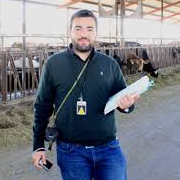Assessing Energy Requirements and Related Economic and Environmental Impact in Livestock Farms
A special issue of Agriculture (ISSN 2077-0472).
Deadline for manuscript submissions: closed (31 May 2019) | Viewed by 13519
Special Issue Editors
Interests: precision livestock farming; animal welfare; milking management; milking systems; wearable technologies; mechanization of livestock farms; ergonomic and safety issues; energy and environmental sustainability of dairy farms; smart glasses for augmented reality; logistics of milk collection
Special Issues, Collections and Topics in MDPI journals
Interests: energy and environmental impact of dairy farms; environmental sustainability of agricultural systems: energy and environmental performance of photovoltaic irrigation systems; precision livestock farming; wearable technologies; mechanization of livestock farms; smart glasses for augmented reality; logistics of milk collection; life cycle assessment; direct and indirect energy analysis of livestock farms
Special Issues, Collections and Topics in MDPI journals
Special Issue Information
Dear Colleagues,
The consumption of fossil fuels has increased since the preindustrial revolution and thus the associated emission of Greenhouse Gases (GHG) into the environment due to human activities. Similarly, livestock farms are continuously developing more intensive systems of management that require a higher utilization of durable and non-durable inputs, which require the consumption of fossil fuels. These inputs are responsible for significant fossil energy requirements, which are related to the remarkable emission of GHG. Fossil energy consumption in agriculture is usually divided into two types, direct and indirect. The first refers to fuels and electricity that are directly converted into units of energy at the farm level; the second one refers to the cumulative energy embodied in all inputs used in the production process. In the last few decades, alternative approaches developed in data modeling have become significantly important in order to predict and manage livestock energy requirements and related environmental emissions.
The intensive mechanization level has decreased the incidence of labor requirements for farm activities and increased the usage of tools, which require fossil fuels. A scientific literature and database review of current studies revealed that a large amount of information about livestock farms and GHG emissions have become available in recent years; however, these outcomes are largely fragmented. The reduction of greenhouse gas emissions from the livestock sector is a critical issue for more sustainable animal production. To achieve this aim, farmers, policy makers, and consumers need clear information about the energy and environmental influence of the livestock product chain.
The aim of this Special Issue of Energies aims to provide innovative experimental research, models and tools focusing on direct and indirect energy requirements in livestock farms, including the related economic and environmental impacts. This Special Issue may include, but is not limited to:
- On-farm diesel and electricity usage
- Embodied energy analysis in durable inputs
- Environmental impact of energy requirements in livestock activities
- Mathematical modelling of on-farm energy consumption
- Economic assessments associated to energy demands
- Renewable energy production in livestock farms
Dr. Maria Caria
Dr. Giuseppe Todde
Guest Editors
Manuscript Submission Information
Manuscripts should be submitted online at www.mdpi.com by registering and logging in to this website. Once you are registered, click here to go to the submission form. Manuscripts can be submitted until the deadline. All submissions that pass pre-check are peer-reviewed. Accepted papers will be published continuously in the journal (as soon as accepted) and will be listed together on the special issue website. Research articles, review articles as well as short communications are invited. For planned papers, a title and short abstract (about 100 words) can be sent to the Editorial Office for announcement on this website.
Submitted manuscripts should not have been published previously, nor be under consideration for publication elsewhere (except conference proceedings papers). All manuscripts are thoroughly refereed through a single-blind peer-review process. A guide for authors and other relevant information for submission of manuscripts is available on the Instructions for Authors page. Agriculture is an international peer-reviewed open access monthly journal published by MDPI.
Please visit the Instructions for Authors page before submitting a manuscript. The Article Processing Charge (APC) for publication in this open access journal is 2600 CHF (Swiss Francs). Submitted papers should be well formatted and use good English. Authors may use MDPI's English editing service prior to publication or during author revisions.
Keywords
- Agricultural machinery and mechanization
- Precision farming
- Energy requirements in livestock activities
- Renewable and Sustainable energy management in animal farms
- Life cycle assessment






